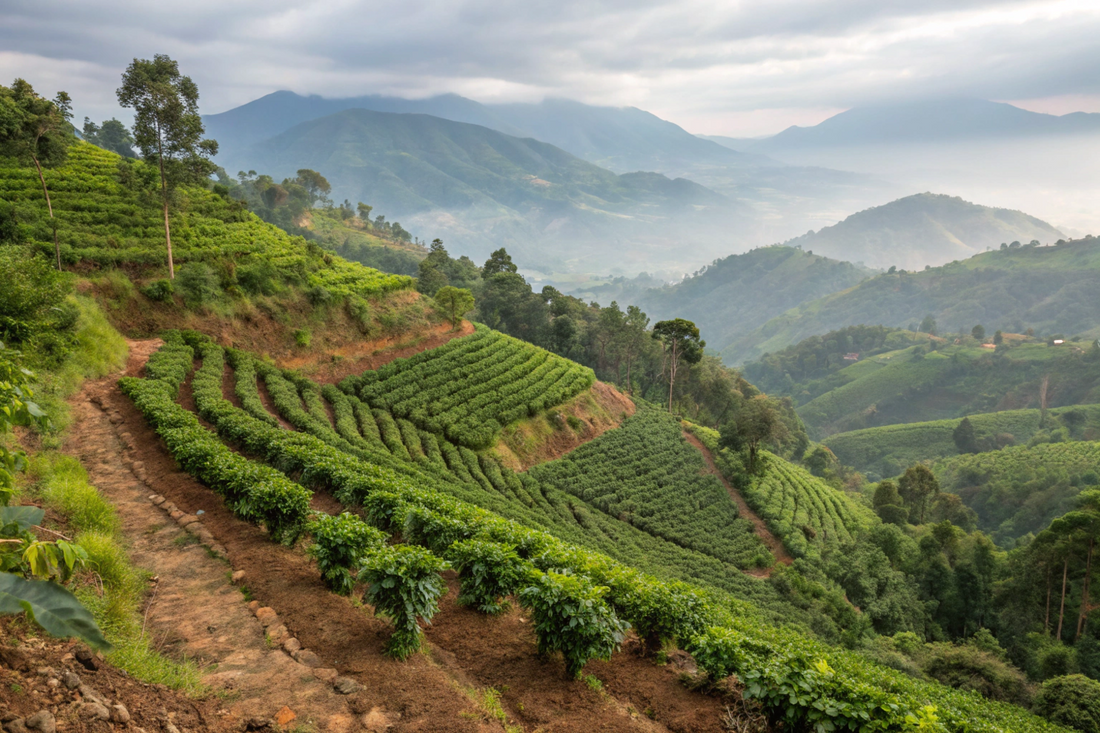
Rwanda’s Rising Coffee Regions
Share
Rwanda Coffee Regions
A Land of a Thousand Hills—and a Thousand Coffee Stories
Perched just south of the equator, Rwanda’s famously rolling terrain has earned it the moniker “The Land of a Thousand Hills.” Over the last two decades, however, those emerald‑green slopes have also become synonymous with another distinction: some of the most sought‑after specialty coffees in the world. From the verdant rim of Lake Kivu to the mist‑kissed heights of the Huye Mountains, Rwandan specialty coffee has emerged as a benchmark for clarity, sweetness, and floral complexity. Yet the country’s meteoric rise is not merely about cup scores or auction records. It is a story of resilience in the wake of tragedy, of smallholder ingenuity, and of communities that have rebuilt their identities bean by bean.
In this deep dive, we will traverse Rwanda’s major coffee‑growing provinces—Western, Southern, Northern, and Eastern—unpacking the terroir, processing innovations, and human narratives that make each micro‑origin distinct. Whether you are a roaster sourcing your next single-origin African coffee lot or a traveler plotting a coffee pilgrimage, consider this your comprehensive guide to the hills, valleys, and washing stations that define Rwanda’s specialty scene.
Rwanda’s Coffee History in Brief: From Colonial Commodity to Specialty Crown Jewel
Coffee first arrived in Rwanda during the early 1900s under German colonial rule, but it was Belgian administrators who enforced widespread planting of low‑quality, high‑yield varieties to satisfy European demand. For decades, coffee was treated as a commodity: volumes were high, prices were low, and farmers were trapped in a cycle of subsistence.
The 1994 genocide against the Tutsi devastated every sector of the economy, including coffee. Yet it was in the ashes of that national trauma that Rwanda’s coffee renaissance began. International NGOs, in partnership with the Rwandan government, introduced quality‑focused training, invested in communal coffee washing stations, and promoted Bourbon coffee varieties known for their sweetness and balance. The result was a dramatic shift from bulk commercial grade to microlots that routinely command top scores at Cup of Excellence Rwanda competitions. Today, Rwandan specialty coffee accounts for roughly 24% of Rwanda’s agricultural exports, and more than 400,000 smallholder farmers depend on the crop for their livelihoods.
The Unique Terroir of Rwanda: Volcanic Soils, High Elevations, and Equatorial Sunshine
Rwanda’s terroir reads like a wish list for specialty coffee agronomists. The country’s average elevation hovers around 1,600 meters, with many farms climbing well above 2,000 meters. Such altitudes slow bean maturation, allowing sugars to concentrate and acids to develop nuanced complexity. These high altitude coffee farms benefit from a network of dormant volcanoes that enrich the soil with phosphorus‑rich ash. Combined with ample rainfall—averaging 1,200–1,600 mm annually—and equatorial sunshine, this ecosystem creates an ideal environment for Arabica coffee in Rwanda.
Volcanic soil coffee grown in this environment exhibits distinct flavor profiles that rival the best from other African coffee origins. Beyond geography, terroir in Rwanda is a cultural and ecological tapestry interwoven with micro‑climates, traditional farming practices, and innovative coffee processing methods.
Western Province: The Lake Kivu Belt
Skirting the western border with the Democratic Republic of Congo, Lake Kivu stretches like a sapphire ribbon at the foot of the Albertine Rift. The lake’s moderating influence tempers daytime heat and traps evening humidity, creating a natural greenhouse effect. Districts such as Nyamasheke, Rutsiro, Rubavu, Karongi, and Ngororero host thousands of small plots ranging from 1,450 to 2,100 meters in elevation.
Coffees from this region offer a hallmark of single origin African coffee: tea-like body, sparkling citric acidity, and flavor notes of Meyer lemon, white peach, and black tea. When naturally processed—a growing trend thanks to improved drying infrastructure—expect tropical bursts of pineapple and guava layered with chocolate undertones.
Western Province has been a leader in sustainable coffee farming. Cooperatives like COOPAC pioneered traceable microplots, integrating organic practices and eco‑friendly Penagos pulpers. Projects like Kinini Kivu are experimenting with extended anaerobic fermentation, further enriching the coffee flavor profiles.
Southern Province: Huye, Nyamagabe, and the Birthplace of Rwanda’s Specialty Movement
Southern Rwanda is home to the misty ridgelines of Huye and Nyamagabe, where elevations soar to 2,300 meters and cool mist from Nyungwe Forest slows cherry maturation. This region is the cradle of Rwanda’s specialty coffee movement, where women in coffee in Rwanda have also played a transformative role.
Maraba Cooperative put Rwanda on the specialty map in 2002. Buf Café, led by trailblazer Epiphanie Mukashyaka, became the first woman‑owned washing station in Rwanda. Today, Buf’s lots regularly place in Cup of Excellence Rwanda competitions, known for their syrupy bodies and floral notes of orange blossom and bergamot.
Community development and transparent premium distribution are central here. Cooperatives often use sustainable models to allocate income toward water tanks, schools, and agronomic training, promoting true equitable growth.
Northern Province: Gakenke, Rulindo, and the Virunga Highlands
Bordering gorilla habitats and blanketed in mineral-rich volcanic soil, Northern Province coffee regions like Gakenke and Rulindo are among Rwanda’s highest. Coffees here share floral aromatics with Ethiopia’s famed Yirgacheffe region, offering jasmine, violet, apricot, and wine-like acidity.
Musasa Dukunde Kawa and Twongere Kawa Coko cooperatives focus heavily on quality control and youth engagement. Their programs train the next generation of coffee farmers in cupping, entrepreneurship, and sustainable coffee farming.
Due to the proximity to sensitive ecosystems, these districts also lead in environmental stewardship. Effluent treatment, carbon sequestration through vetiver planting, and wetland regeneration all contribute to the conservation of gorilla habitats.
Eastern Province: Kayonza, Gatsibo, and the Savanna Fringe
The Eastern Province transitions into Rwanda’s savanna, where coffee flavor profiles differ markedly—lighter bodies but intense sweetness with notes of panela, tamarind, and cardamom. With lower rainfall, innovative irrigation and mulching techniques have allowed Eastern producers to create unique, high-quality microlots.
Cooperatives like Gatsibo Karama Women’s Cooperative and Kayonza Coffee Project are pioneering experimental methods such as carbonic maceration and intercropping. These practices boost resilience while enhancing the layered complexity of the coffees.
Gishwati Forest & the Western Highlands: Biodiversity Meets Coffee
Near the Gishwati-Mukura National Park, shade-grown coffee mimics the cloud forests of Central America. These high altitude coffees offer lavender aromatics, red currant brightness, and a silky caramel finish.
The Gishwati Coffee Alliance integrates reforestation with coffee production. Farmers plant indigenous trees for every kilo of coffee sold, promoting biodiversity and long-term soil health.
Emerging Regions & Experimental Farms: The Frontier of Rwandan Coffee
As land pressure mounts in traditional regions, new frontiers such as Bugesera and Burera are embracing disease-resistant cultivars like SL28 and Batian. Here, young entrepreneurs are turning Rwanda’s coffee renaissance into a new era of innovation.
Ngoma’s Umuko Cooperative is a model for innovation, using solar dryers to improve honey-process coffees. These technologies enhance quality while lowering energy consumption—key for building Rwanda’s future in sustainable coffee farming.
Processing Methods & Quality Control: The Science Behind the Cup
From washed coffees processed through triple flotation to carefully controlled natural and honey methods, Rwanda excels in coffee processing methods that ensure clarity and consistency. Quality control is rigorous, with digital moisture meters, daily cupping, and color sorting machines in use at most stations.
Challenges & Opportunities: Navigating the Next Decade
Despite growth, climate change and pest pressures like the antestia bug remain challenges. The Rwanda Agriculture Board is developing pest-resistant Arabica coffee varieties and promoting integrated pest management.
Logistical barriers due to Rwanda’s landlocked geography are being addressed through cold-chain transport and Kigali’s expanding airport. Simultaneously, programs such as Sustain Coffee Youth Corps encourage youth to join the coffee sector, boosting long-term viability.
Visiting Rwanda’s Coffee Routes: From Crop to Cup Tourism
Coffee tourism in Rwanda is thriving. Whether it’s hiking the Huye Mountain Experience, kayaking along Lake Kivu, or gorilla trekking followed by a Gakenke pour-over, Rwanda coffee tourism offers immersive and educational adventures. These routes support local communities, promoting equitable and sustainable travel.
The Road Ahead for Rwanda’s Coffee Renaissance
From high altitude coffee farms on the slopes of Huye to volcanic soil coffee terraces near Lake Kivu, Rwanda has emerged as a leader in single origin African coffee. Through sustainable coffee farming, innovative coffee processing methods, and cooperative structures that champion transparency and women’s empowerment, Rwanda’s coffee scene continues to flourish.
As the sun dips behind the Virunga peaks, illuminating parchment-covered drying beds, one truth remains: Rwanda’s coffee story is far from over. With rising global interest in African coffee origins and increasing attention to traceability, Rwanda stands ready to become a cornerstone of the specialty coffee world—bean by bean, cup by cup.

